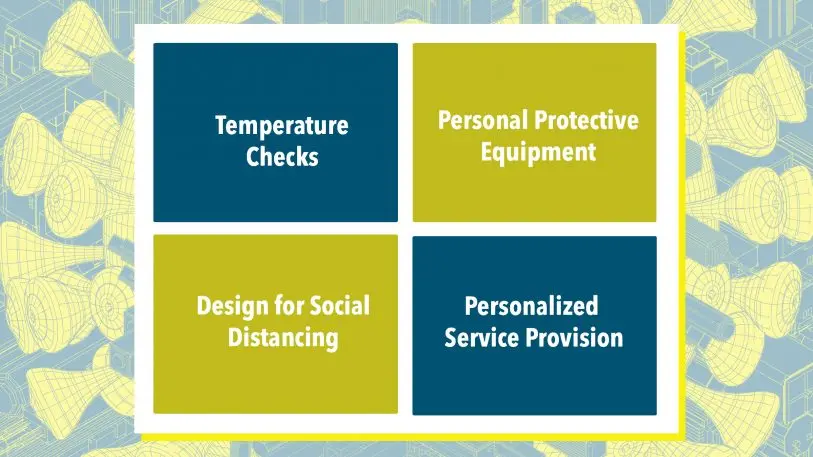Much of America is under lockdown to slow the spread of the deadly coronavirus. In a couple months, when this first phase of the crisis has passed, businesses will start to reopen and the economy will sputter to life.
But it won’t be as if someone hits a button and things instantly reset to the way they were. Like other historical pandemics, this one is likely to recur in waves over the next 6 to 18 months, flaring up in hot spots and threatening to spread again. The Spanish flu pandemic, which started in 1918, played out in three waves before it finally stopped being a deadly threat in 1920, and it wasn’t until 1922 that people felt secure in crowded spaces. Our own interim period may be shorter or longer, depending on how quickly antiviral therapies are put in place, a vaccine is mass-produced, or we develop herd immunity. Businesses will have to prepare for this new normal.
To better understand how, we talked with business leaders, city and state officials, and medical and health professionals. We immersed ourselves in the history and track record of successful responses to previous pandemics. We reviewed what is happening and looks to be working in other countries like China, Singapore, and South Korea. And we took a close look at the industries and occupations that are on the front lines of the battle and need to be the most prepared. Putting it all together, we developed a four-point plan for American businesses as they get ready to reopen.

Sophisticated protective equipment for frontline workers and the public
Frontline workers need to be equipped with masks, gloves, and other personal protective equipment (PPE) to do their jobs safely. That includes everyone from doctors, emergency responders, physicians’ assistants, and nurses to grocery clerks, warehouse pickers, and delivery workers. They are the true heroes of the battle against coronavirus.
But they aren’t alone. Nearly one in three American workers have jobs that require them to work in close proximity to each other and have direct contact with the public. They’re cashiers, retail workers, flight attendants, airline staff, transit workers, ride-share and taxi drivers, beauticians at hair and nail salons, restaurant and food service workers, landscapers, road crews, plumbers, carpenters, handymen, and home appliance repair techs, to name a few. Though some are making do with DIY masks or nothing at all, medical-grade masks and gear are needed. PPE should also be made mandatory (and provided for a cost if needed) at airports, on transit, in schools, and anywhere people come together in large numbers. A study showed that the combination of masks, gloves, protective gear, and regular handwashing reduced the transmission of the deadly SARS virus by more than 90%.
One problem: Masks and other protective items are often poorly designed and visually obtrusive, which could make it harder to encourage people to wear them. Apparel brands like Brooks Brothers and Under Armour are already repurposing production lines to create masks. They should enlist their designers to make the masks less frightening, too. Large companies should also step up. Just as airlines and luxury hotels tap designers to create uniforms that are stylish, companies like Amazon, UPS, FedEx, Walmart, Instacart, and Uber could mobilize fashion designers to create PPE that looks more like normal workwear. Not only are their workers demanding protective gear, their customers will feel safer if it’s provided.
Design for social distancing
Social and physical distancing will be a reality for at least the next year and a half, possibly longer, depending on when a vaccine is ready. Businesses will have to make design changes to ensure their offices, factories, and retail outposts enable social distancing. A lot of this is low-hanging fruit—we’ve all seen news photos of grocery stores with lines taped or painted on the floor to separate people.
Other institutions and spaces will require bigger retrofits. Take airports and airlines. Lines for security and custom checks will need to be brought under control and crowding reduced in baggage claim areas and at gates. Similar retrofits will be needed before people feel safe returning to arenas, stadiums, theaters, and malls. Lines will have to be widely spaced, waiting and concession areas will need to be redesigned for distancing, and seating will have to be spaced further apart—perhaps by leaving some seats unoccupied. Restaurants will need to space their tables and waiting lines. Fitness studios will have to ensure that there is adequate distancing and that patrons and trainers wear protective equipment. Hair and nail salons will also need a combination of distancing and PPE to ensure that employees and customers are safe.
Some of these businesses may have to embrace more personalized services. Even before the pandemic, restaurants were shifting to delivery. This trend will steepen for as long as people are scared to visit crowded spaces. Reports indicate that this is happening in China. Hair and nail salons, fitness providers, and more will have more clients who want in-home services. Restaurants and bars will find demand for catering small gatherings of family and friends. The same goes for musicians and performers, who are likely to see demand for house concerts increase.
While large corporations have the resources and expertise to make these retrofits, smaller businesses are already strapped; some projections suggest that as many as three-quarters of them may be headed for bankruptcy. This cannot be allowed to happen. Imagine walking down commercial streets in the not-too-distant future only to see empty storefronts, boarded-up shops, and virtually no independent cafes, restaurants, and cultural venues. We have to mobilize now to keep our commercial districts alive. Smaller businesses and nonprofits will require technical and management advice from chambers of commerce, small business associations, and economic development corporations, as well as loans, grants, and financial assistance.
Universities and colleges are now being rushed into the world of online learning. This will only accelerate. But universities and colleges also bring large groups of students together in dormitories and dining halls. If we hope to reopen them in the fall, those facilities will also have to be retrofitted for safety. That means staggering dining times to ensure adequate distancing. Dorms will need to be cleaned more often, and some of their common areas closed.
Temperature checks and health screenings
Regular health checks at airports, office buildings, theaters, arenas, schools, and dormitories will become a part of our lives as the nation reopens, like security checks. This is already common in Asia; in Singapore, for example, workers have their temperatures checked as they enter office buildings. As testing for the virus becomes widely available, it can be used to verify which workers have had the virus and can safely resume work without risk to other workers or customers.
Going remote and online
The lockdown forced millions of professionals to work from home, reinforcing a trend that was already accelerating. As the nation begins to reopen, many commuters will want to avoid crowded buses, trains, and subways, bringing already crowded highways to a standstill. Cities and businesses may find themselves incentivizing remote work, if for no other reason than to control traffic congestion.
Cities that invest in and target remote workers may find themselves at an advantage. Tulsa, Oklahoma’s Tulsa Remote, a program that offers $10,000 grants, access to affordable housing, and the opportunity to forge deeper civic connections, has attracted thousands of applicants from across the country. Companies can take advantage of such programs to provide remote work alternatives to anxious workers in expensive big cities. Cities can use them to bolster their local job markets and economies.
Conferences and business networks will also need to move online for at least the next 12 to 18 months. It is hard to imagine people being ready to return to large business conferences and expos while the threat of the virus is still out there.
An urgent need
The time to get ready, for this critical transition period is now. As we mobilize to create surge capacity in our hospitals, give our frontline providers the PPE they need, develop the vaccines and therapies that will bring the virus to heel, and offer relief to those reeling from the economic fallout, businesses must also work, alongside various levels of government, to put in place a plan to safely restart our economy—and our lives.
Richard Florida is university professor at University of Toronto’s School of Cities and Rotman School of Management and distinguished fellow at NYU’s Shack Institute of Real Estate, and cofounder and editor-at-large of The Atlantic’s CityLab. Rana Florida is CEO of the Creative Class Group and the author of Upgrade.
Recognize your brand’s excellence by applying to this year’s Brands That Matter Awards before the early-rate deadline, May 3.
